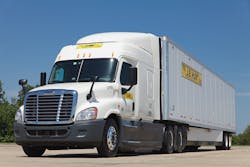Tax reform is proving beneficial to the bottom line of J.B. Hunt Transport Services, as it said its fourth quarter 2017 results now include a $309.2 million decrease in income taxes from deferred tax balances as a result of the Tax Cuts and Jobs Act enacted last year.
That helped the multi-modal carrier post net earnings of $385.3 million on $1.99 billion in operating revenue in the fourth quarter of 2017, or more than twice its net earnings of $117.6 million on $1.72 billion in operating revenue for the fourth quarter of 2016.
The company noted, however, that it took several charges against its fourth quarter 2017 earnings, too: a pre-tax charges of $20.3 million for a reserve on a cash advance for the purchase of new trailers from a manufacturer J.B. Hunt said “will not meet delivery” and $18.6 million for an increase in reserves for certain insurance and claims.
For 2017, J.B. Hunt said net earnings topped $686.6 million on total operating revenue of over $7.18 billion, which includes over $753.7 million in fuel surcharges, compared to net earnings of over $432 million on total operating revenues of over $6.55 billion (including $548.1 million in fuel surcharges) for 2016.
In terms of specific segments of freight demand, the company its intermodal division witnessed load growth of 5% and a 10% increase in segment revenue, while its Dedicated Contract Services (DCS) segment revenue increased by 20%, primarily from the addition of new customer accounts and improved asset utilization.
The carrier added that its Integrated Capacity Solutions (ICS) segment revenue increased by 40% primarily from a 19% increase in revenue per load and a 17% increase in load growth, while revenue within its truckload division (JBT) increased 1% primarily from customer rate per mile increases offset by a decrease in load count.
Other trends noted by J.B. Hunt in its earnings report:
- Operating income within its intermodal division decreased 25% compared to 2016 as benefits from increased volume and revenue per load were offset by increased costs to attract and retain drivers, higher third-party dray costs, increased insurance and claims costs and inefficiencies in the rail networks due to congestion and track and yard maintenance.
- Its DCS division added 1,326 revenue producing trucks in year-over-year comparisons between 2017 and 2016, with about 53% of those additions representing private fleet conversions and new contract implementations in this and prior periods. Customer retention rates remain above 98%.
- Yet DCS operating income decreased by 39% even though its revenues were up 20% due to higher driver wages – including the timing between wage increases and recovery through customer contracts – higher driver recruiting costs including the length of time to fill open positions, increased insurance and claims costs, plus higher equipment ownership costs compared to the same period in 2016.
- Within its ICS division, J.B. Hunt noted contractual volumes represent approximately 66% of the total load volume but only 46% of the total revenue in fourth quarter of 2017 compared to 75% and 62%, respectively, in fourth quarter of 2016. Yet operating income increased 86% over the same period in 2016, with gross profit margin increasing to 14.1% versus 12.9% last year primarily from the increased spot market activity which more than offset the margin compression realized in the contractual volumes.
- In its truckload segment, J.B. Hunt said that while revenue per load increased 13% primarily from a 12% increase in rates per loaded mile in the fourth quarter of 2017 when compared to equivalent lengths of haul in the fourth quarter 2016, those gains were offset by a 10% decrease in load count, higher driver wages and independent contractor costs, lower tractor utilization due to an increase in unseated trucks.
About the Author
Fleet Owner Staff
Our Editorial Team
Kevin Jones, Editorial Director, Commercial Vehicle Group
Cristina Commendatore, Executive Editor
Scott Achelpohl, Managing Editor
Josh Fisher, Senior Editor
Catharine Conway, Digital Editor
Eric Van Egeren, Art Director
